Decision Making Models for Employee Retention at Sainsbury's
VerifiedAdded on 2020/07/22
|26
|8941
|160
Report
AI Summary
This report delves into the critical area of decision-making, particularly within the context of addressing employee turnover at Sainsbury's. It begins by introducing the core concepts of decision-making, emphasizing the importance of selecting the most effective course of action to solve organizational problems. The report then proceeds to design a solution-finding model tailored to the specific challenges of human resource management, with employee turnover identified as a significant issue. It explores the classical and rational models of decision-making, outlining the steps involved, assumptions, and the tools required for implementation. The report further analyzes a decision-making model aimed at reducing employee turnover, providing a reflective analysis of the strategies and their potential impact. The report concludes with a discussion on the practical application of these models in the context of Sainsbury's, aiming to provide insights into improving employee retention and organizational effectiveness. The report extensively discusses classical and rational decision making models, providing the steps, advantages, and disadvantages. The report also outlines the importance of considering factors such as financial resources, manpower, and potential employee resistance when implementing decision-making strategies.

Problem solving and
decision making
decision making
Paraphrase This Document
Need a fresh take? Get an instant paraphrase of this document with our AI Paraphraser
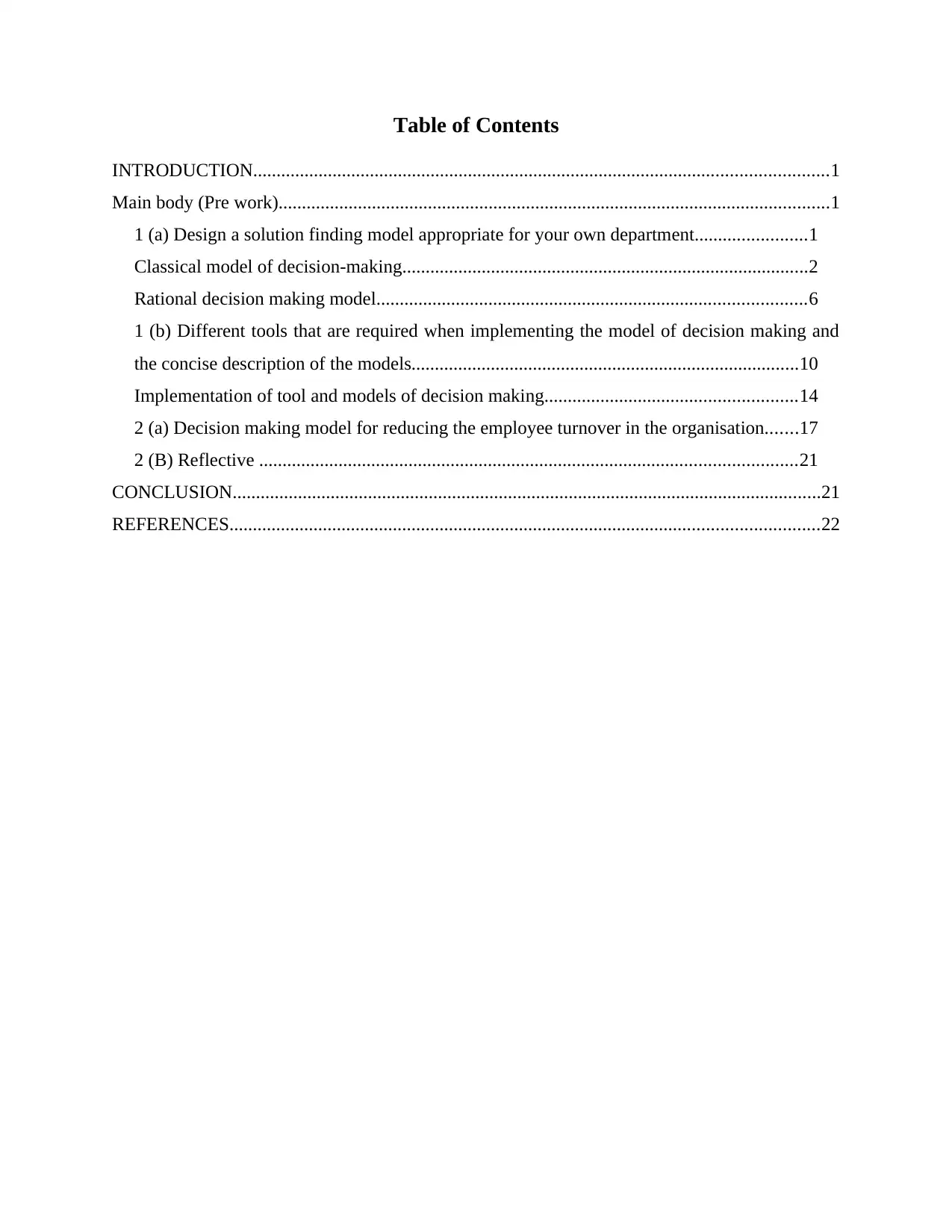
Table of Contents
INTRODUCTION...........................................................................................................................1
Main body (Pre work)......................................................................................................................1
1 (a) Design a solution finding model appropriate for your own department........................1
Classical model of decision-making.......................................................................................2
Rational decision making model............................................................................................6
1 (b) Different tools that are required when implementing the model of decision making and
the concise description of the models...................................................................................10
Implementation of tool and models of decision making......................................................14
2 (a) Decision making model for reducing the employee turnover in the organisation.......17
2 (B) Reflective ...................................................................................................................21
CONCLUSION..............................................................................................................................21
REFERENCES..............................................................................................................................22
INTRODUCTION...........................................................................................................................1
Main body (Pre work)......................................................................................................................1
1 (a) Design a solution finding model appropriate for your own department........................1
Classical model of decision-making.......................................................................................2
Rational decision making model............................................................................................6
1 (b) Different tools that are required when implementing the model of decision making and
the concise description of the models...................................................................................10
Implementation of tool and models of decision making......................................................14
2 (a) Decision making model for reducing the employee turnover in the organisation.......17
2 (B) Reflective ...................................................................................................................21
CONCLUSION..............................................................................................................................21
REFERENCES..............................................................................................................................22
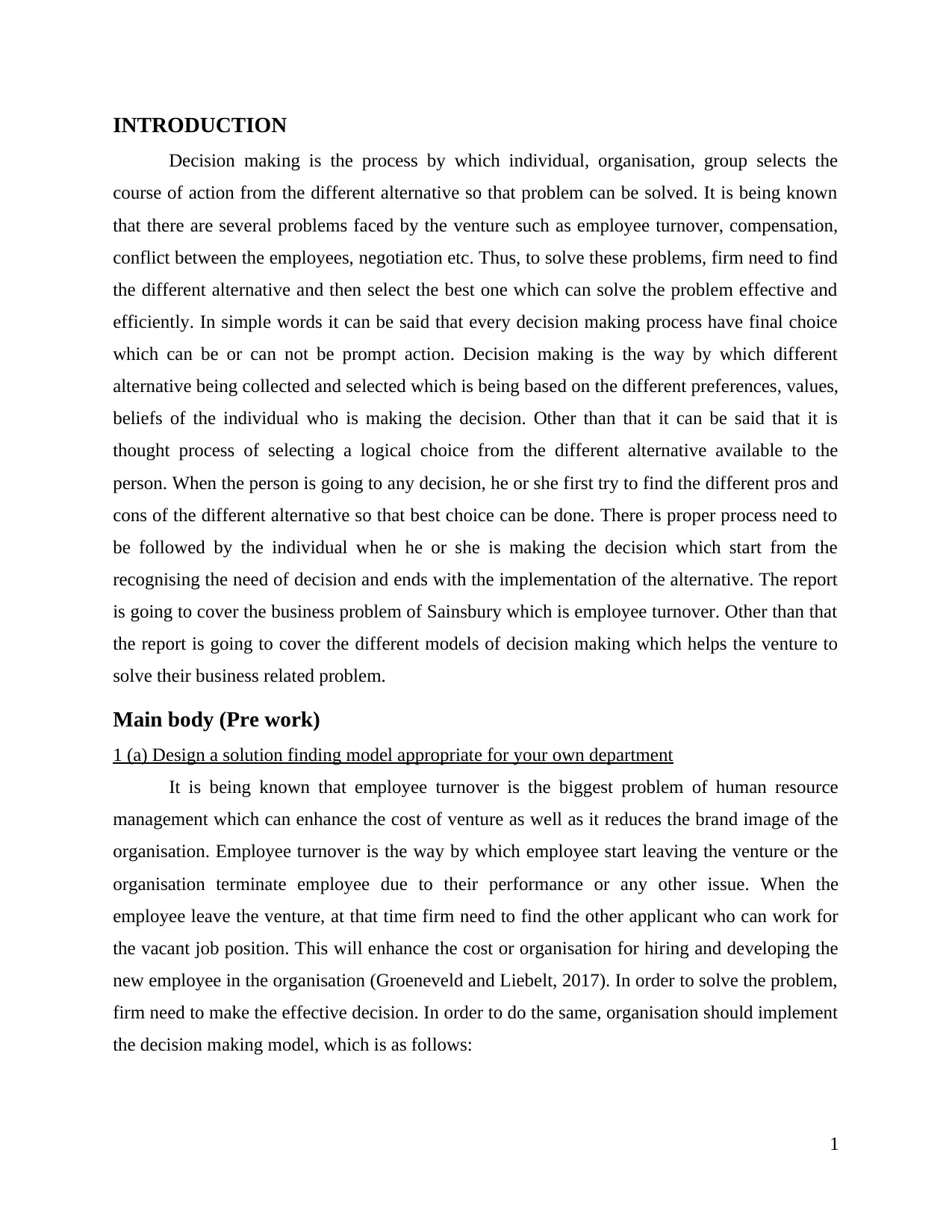
INTRODUCTION
Decision making is the process by which individual, organisation, group selects the
course of action from the different alternative so that problem can be solved. It is being known
that there are several problems faced by the venture such as employee turnover, compensation,
conflict between the employees, negotiation etc. Thus, to solve these problems, firm need to find
the different alternative and then select the best one which can solve the problem effective and
efficiently. In simple words it can be said that every decision making process have final choice
which can be or can not be prompt action. Decision making is the way by which different
alternative being collected and selected which is being based on the different preferences, values,
beliefs of the individual who is making the decision. Other than that it can be said that it is
thought process of selecting a logical choice from the different alternative available to the
person. When the person is going to any decision, he or she first try to find the different pros and
cons of the different alternative so that best choice can be done. There is proper process need to
be followed by the individual when he or she is making the decision which start from the
recognising the need of decision and ends with the implementation of the alternative. The report
is going to cover the business problem of Sainsbury which is employee turnover. Other than that
the report is going to cover the different models of decision making which helps the venture to
solve their business related problem.
Main body (Pre work)
1 (a) Design a solution finding model appropriate for your own department
It is being known that employee turnover is the biggest problem of human resource
management which can enhance the cost of venture as well as it reduces the brand image of the
organisation. Employee turnover is the way by which employee start leaving the venture or the
organisation terminate employee due to their performance or any other issue. When the
employee leave the venture, at that time firm need to find the other applicant who can work for
the vacant job position. This will enhance the cost or organisation for hiring and developing the
new employee in the organisation (Groeneveld and Liebelt, 2017). In order to solve the problem,
firm need to make the effective decision. In order to do the same, organisation should implement
the decision making model, which is as follows:
1
Decision making is the process by which individual, organisation, group selects the
course of action from the different alternative so that problem can be solved. It is being known
that there are several problems faced by the venture such as employee turnover, compensation,
conflict between the employees, negotiation etc. Thus, to solve these problems, firm need to find
the different alternative and then select the best one which can solve the problem effective and
efficiently. In simple words it can be said that every decision making process have final choice
which can be or can not be prompt action. Decision making is the way by which different
alternative being collected and selected which is being based on the different preferences, values,
beliefs of the individual who is making the decision. Other than that it can be said that it is
thought process of selecting a logical choice from the different alternative available to the
person. When the person is going to any decision, he or she first try to find the different pros and
cons of the different alternative so that best choice can be done. There is proper process need to
be followed by the individual when he or she is making the decision which start from the
recognising the need of decision and ends with the implementation of the alternative. The report
is going to cover the business problem of Sainsbury which is employee turnover. Other than that
the report is going to cover the different models of decision making which helps the venture to
solve their business related problem.
Main body (Pre work)
1 (a) Design a solution finding model appropriate for your own department
It is being known that employee turnover is the biggest problem of human resource
management which can enhance the cost of venture as well as it reduces the brand image of the
organisation. Employee turnover is the way by which employee start leaving the venture or the
organisation terminate employee due to their performance or any other issue. When the
employee leave the venture, at that time firm need to find the other applicant who can work for
the vacant job position. This will enhance the cost or organisation for hiring and developing the
new employee in the organisation (Groeneveld and Liebelt, 2017). In order to solve the problem,
firm need to make the effective decision. In order to do the same, organisation should implement
the decision making model, which is as follows:
1
⊘ This is a preview!⊘
Do you want full access?
Subscribe today to unlock all pages.

Trusted by 1+ million students worldwide
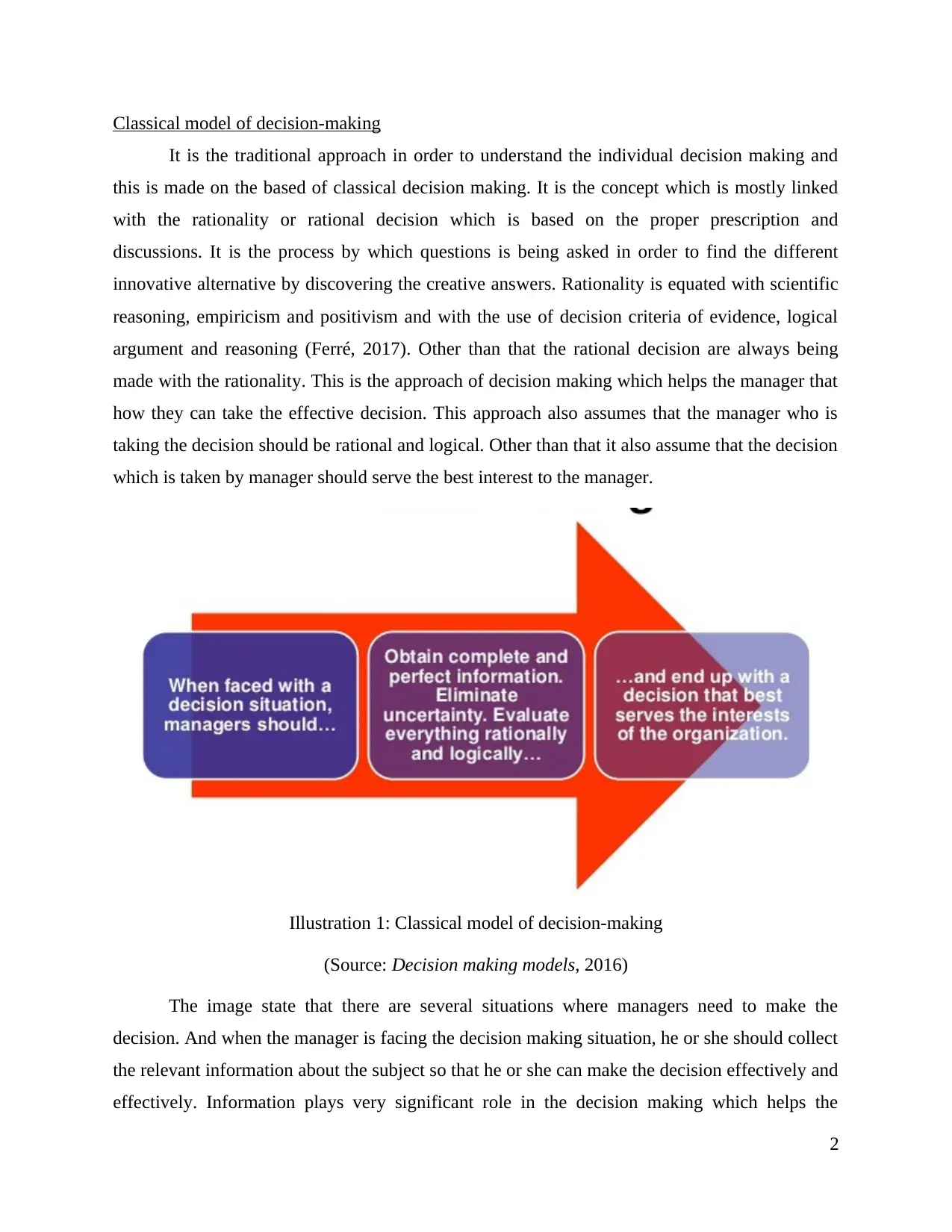
Classical model of decision-making
It is the traditional approach in order to understand the individual decision making and
this is made on the based of classical decision making. It is the concept which is mostly linked
with the rationality or rational decision which is based on the proper prescription and
discussions. It is the process by which questions is being asked in order to find the different
innovative alternative by discovering the creative answers. Rationality is equated with scientific
reasoning, empiricism and positivism and with the use of decision criteria of evidence, logical
argument and reasoning (Ferré, 2017). Other than that the rational decision are always being
made with the rationality. This is the approach of decision making which helps the manager that
how they can take the effective decision. This approach also assumes that the manager who is
taking the decision should be rational and logical. Other than that it also assume that the decision
which is taken by manager should serve the best interest to the manager.
Illustration 1: Classical model of decision-making
(Source: Decision making models, 2016)
The image state that there are several situations where managers need to make the
decision. And when the manager is facing the decision making situation, he or she should collect
the relevant information about the subject so that he or she can make the decision effectively and
effectively. Information plays very significant role in the decision making which helps the
2
It is the traditional approach in order to understand the individual decision making and
this is made on the based of classical decision making. It is the concept which is mostly linked
with the rationality or rational decision which is based on the proper prescription and
discussions. It is the process by which questions is being asked in order to find the different
innovative alternative by discovering the creative answers. Rationality is equated with scientific
reasoning, empiricism and positivism and with the use of decision criteria of evidence, logical
argument and reasoning (Ferré, 2017). Other than that the rational decision are always being
made with the rationality. This is the approach of decision making which helps the manager that
how they can take the effective decision. This approach also assumes that the manager who is
taking the decision should be rational and logical. Other than that it also assume that the decision
which is taken by manager should serve the best interest to the manager.
Illustration 1: Classical model of decision-making
(Source: Decision making models, 2016)
The image state that there are several situations where managers need to make the
decision. And when the manager is facing the decision making situation, he or she should collect
the relevant information about the subject so that he or she can make the decision effectively and
effectively. Information plays very significant role in the decision making which helps the
2
Paraphrase This Document
Need a fresh take? Get an instant paraphrase of this document with our AI Paraphraser

manager to find the cause and effect of the decision made by them. Information should be
relevant to the choice of problem and about the different alternative which is being selected by
the decision maker. Other than that information should also been communicated to all the
members who are involved in the decision making. The firm should involve employees in the
decision making so that they find the different innovative alternative and choices which helps the
manager to make the effective decision (Voskuilen and McKoon, 2017). Other than that the
decision which is being made by the manager should made for the organisation interest not for
the self interest of the manager. There are 3 steps that are included in the classical decision
making which helps the manager to keep his or her focus on the different facts and logic and
ignore the inappropriate pitfalls and assumptions. This is designed to help the manager to
approach at the rational or logical decision making. The steps are as follows:
Stage 1: List all the alternative courses of action possible and the consequences of the
different alternative
The first stage of the classical decision making is find the problem and what are the
different causes of the problem. Further, firm need to find the different alternative which can
helps the organisation to solve the problem. Proper meeting are conducted in the organisation so
that manager can collect the information from different people in the venture. That information
helps the manager to find the various alternative which can be implemented to attain the
objectives. Other than that meeting helps the manager to find the view points of different people
who are involved in the decision making and implementation of alternative. In this stage, all the
alternative is being evaluated and then manager find out the different consequences which are
associated with the each alternative (Fahimnia and Farahani, 2017). The key objective of this
stage is reduced the uncertainty in the boniness and external environment, which can be reduced
with the help of evaluation of all the alternative. Further, manager find the different advantages
and disadvantages associated with the alternative. This is done because it helps the manager to
select the best alternative in order to solve the problem. Here the organisation is facing employee
turnover, which is increasing the cost of human resource management and organisation.
Manager here need to find the different causes that what are factors which motivates the
employees to leave the organisation (Salas and Martin, 2017). Then manager need to find the
different ways by which he or she can retain employees in the organisation such as promotion,
3
relevant to the choice of problem and about the different alternative which is being selected by
the decision maker. Other than that information should also been communicated to all the
members who are involved in the decision making. The firm should involve employees in the
decision making so that they find the different innovative alternative and choices which helps the
manager to make the effective decision (Voskuilen and McKoon, 2017). Other than that the
decision which is being made by the manager should made for the organisation interest not for
the self interest of the manager. There are 3 steps that are included in the classical decision
making which helps the manager to keep his or her focus on the different facts and logic and
ignore the inappropriate pitfalls and assumptions. This is designed to help the manager to
approach at the rational or logical decision making. The steps are as follows:
Stage 1: List all the alternative courses of action possible and the consequences of the
different alternative
The first stage of the classical decision making is find the problem and what are the
different causes of the problem. Further, firm need to find the different alternative which can
helps the organisation to solve the problem. Proper meeting are conducted in the organisation so
that manager can collect the information from different people in the venture. That information
helps the manager to find the various alternative which can be implemented to attain the
objectives. Other than that meeting helps the manager to find the view points of different people
who are involved in the decision making and implementation of alternative. In this stage, all the
alternative is being evaluated and then manager find out the different consequences which are
associated with the each alternative (Fahimnia and Farahani, 2017). The key objective of this
stage is reduced the uncertainty in the boniness and external environment, which can be reduced
with the help of evaluation of all the alternative. Further, manager find the different advantages
and disadvantages associated with the alternative. This is done because it helps the manager to
select the best alternative in order to solve the problem. Here the organisation is facing employee
turnover, which is increasing the cost of human resource management and organisation.
Manager here need to find the different causes that what are factors which motivates the
employees to leave the organisation (Salas and Martin, 2017). Then manager need to find the
different ways by which he or she can retain employees in the organisation such as promotion,
3
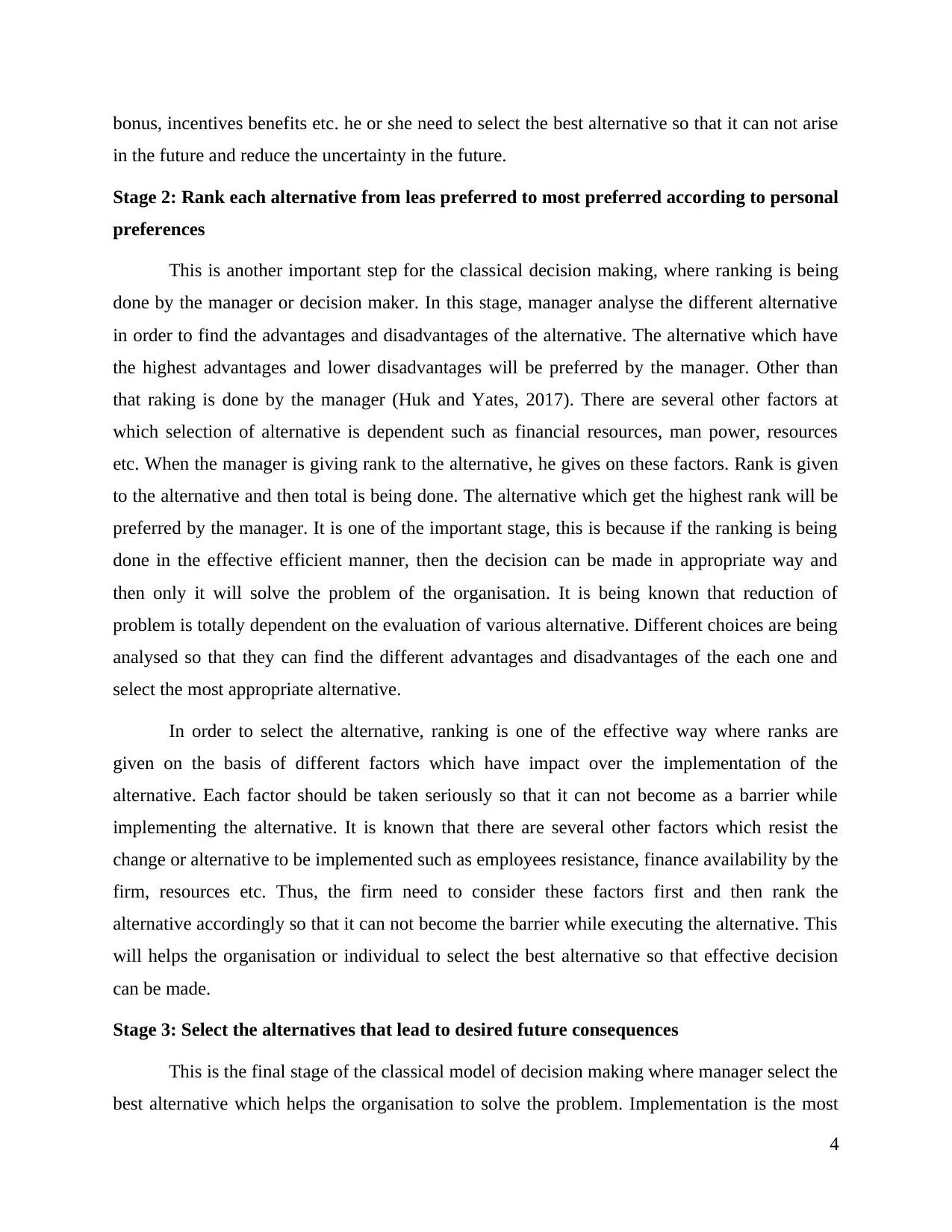
bonus, incentives benefits etc. he or she need to select the best alternative so that it can not arise
in the future and reduce the uncertainty in the future.
Stage 2: Rank each alternative from leas preferred to most preferred according to personal
preferences
This is another important step for the classical decision making, where ranking is being
done by the manager or decision maker. In this stage, manager analyse the different alternative
in order to find the advantages and disadvantages of the alternative. The alternative which have
the highest advantages and lower disadvantages will be preferred by the manager. Other than
that raking is done by the manager (Huk and Yates, 2017). There are several other factors at
which selection of alternative is dependent such as financial resources, man power, resources
etc. When the manager is giving rank to the alternative, he gives on these factors. Rank is given
to the alternative and then total is being done. The alternative which get the highest rank will be
preferred by the manager. It is one of the important stage, this is because if the ranking is being
done in the effective efficient manner, then the decision can be made in appropriate way and
then only it will solve the problem of the organisation. It is being known that reduction of
problem is totally dependent on the evaluation of various alternative. Different choices are being
analysed so that they can find the different advantages and disadvantages of the each one and
select the most appropriate alternative.
In order to select the alternative, ranking is one of the effective way where ranks are
given on the basis of different factors which have impact over the implementation of the
alternative. Each factor should be taken seriously so that it can not become as a barrier while
implementing the alternative. It is known that there are several other factors which resist the
change or alternative to be implemented such as employees resistance, finance availability by the
firm, resources etc. Thus, the firm need to consider these factors first and then rank the
alternative accordingly so that it can not become the barrier while executing the alternative. This
will helps the organisation or individual to select the best alternative so that effective decision
can be made.
Stage 3: Select the alternatives that lead to desired future consequences
This is the final stage of the classical model of decision making where manager select the
best alternative which helps the organisation to solve the problem. Implementation is the most
4
in the future and reduce the uncertainty in the future.
Stage 2: Rank each alternative from leas preferred to most preferred according to personal
preferences
This is another important step for the classical decision making, where ranking is being
done by the manager or decision maker. In this stage, manager analyse the different alternative
in order to find the advantages and disadvantages of the alternative. The alternative which have
the highest advantages and lower disadvantages will be preferred by the manager. Other than
that raking is done by the manager (Huk and Yates, 2017). There are several other factors at
which selection of alternative is dependent such as financial resources, man power, resources
etc. When the manager is giving rank to the alternative, he gives on these factors. Rank is given
to the alternative and then total is being done. The alternative which get the highest rank will be
preferred by the manager. It is one of the important stage, this is because if the ranking is being
done in the effective efficient manner, then the decision can be made in appropriate way and
then only it will solve the problem of the organisation. It is being known that reduction of
problem is totally dependent on the evaluation of various alternative. Different choices are being
analysed so that they can find the different advantages and disadvantages of the each one and
select the most appropriate alternative.
In order to select the alternative, ranking is one of the effective way where ranks are
given on the basis of different factors which have impact over the implementation of the
alternative. Each factor should be taken seriously so that it can not become as a barrier while
implementing the alternative. It is known that there are several other factors which resist the
change or alternative to be implemented such as employees resistance, finance availability by the
firm, resources etc. Thus, the firm need to consider these factors first and then rank the
alternative accordingly so that it can not become the barrier while executing the alternative. This
will helps the organisation or individual to select the best alternative so that effective decision
can be made.
Stage 3: Select the alternatives that lead to desired future consequences
This is the final stage of the classical model of decision making where manager select the
best alternative which helps the organisation to solve the problem. Implementation is the most
4
⊘ This is a preview!⊘
Do you want full access?
Subscribe today to unlock all pages.

Trusted by 1+ million students worldwide
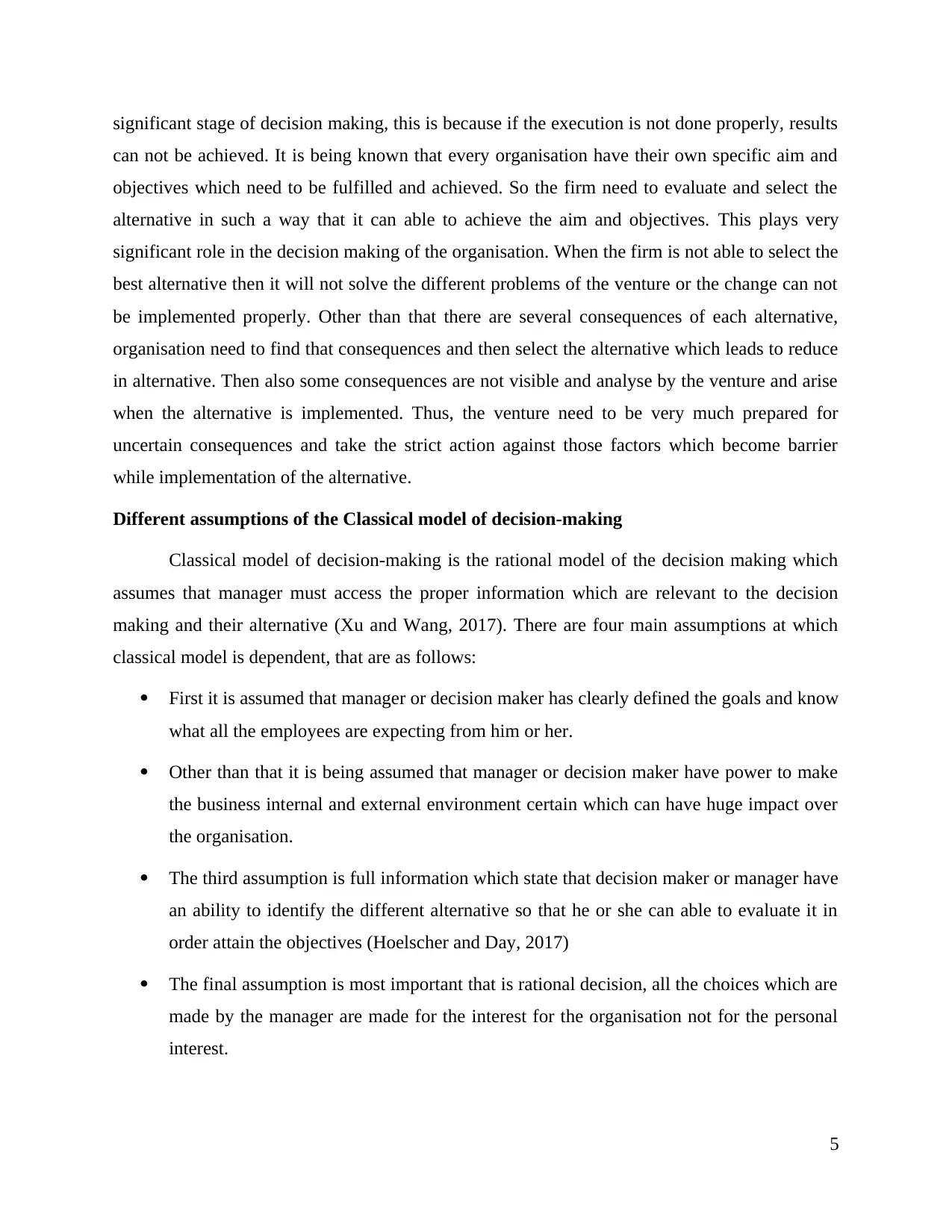
significant stage of decision making, this is because if the execution is not done properly, results
can not be achieved. It is being known that every organisation have their own specific aim and
objectives which need to be fulfilled and achieved. So the firm need to evaluate and select the
alternative in such a way that it can able to achieve the aim and objectives. This plays very
significant role in the decision making of the organisation. When the firm is not able to select the
best alternative then it will not solve the different problems of the venture or the change can not
be implemented properly. Other than that there are several consequences of each alternative,
organisation need to find that consequences and then select the alternative which leads to reduce
in alternative. Then also some consequences are not visible and analyse by the venture and arise
when the alternative is implemented. Thus, the venture need to be very much prepared for
uncertain consequences and take the strict action against those factors which become barrier
while implementation of the alternative.
Different assumptions of the Classical model of decision-making
Classical model of decision-making is the rational model of the decision making which
assumes that manager must access the proper information which are relevant to the decision
making and their alternative (Xu and Wang, 2017). There are four main assumptions at which
classical model is dependent, that are as follows:
First it is assumed that manager or decision maker has clearly defined the goals and know
what all the employees are expecting from him or her.
Other than that it is being assumed that manager or decision maker have power to make
the business internal and external environment certain which can have huge impact over
the organisation.
The third assumption is full information which state that decision maker or manager have
an ability to identify the different alternative so that he or she can able to evaluate it in
order attain the objectives (Hoelscher and Day, 2017)
The final assumption is most important that is rational decision, all the choices which are
made by the manager are made for the interest for the organisation not for the personal
interest.
5
can not be achieved. It is being known that every organisation have their own specific aim and
objectives which need to be fulfilled and achieved. So the firm need to evaluate and select the
alternative in such a way that it can able to achieve the aim and objectives. This plays very
significant role in the decision making of the organisation. When the firm is not able to select the
best alternative then it will not solve the different problems of the venture or the change can not
be implemented properly. Other than that there are several consequences of each alternative,
organisation need to find that consequences and then select the alternative which leads to reduce
in alternative. Then also some consequences are not visible and analyse by the venture and arise
when the alternative is implemented. Thus, the venture need to be very much prepared for
uncertain consequences and take the strict action against those factors which become barrier
while implementation of the alternative.
Different assumptions of the Classical model of decision-making
Classical model of decision-making is the rational model of the decision making which
assumes that manager must access the proper information which are relevant to the decision
making and their alternative (Xu and Wang, 2017). There are four main assumptions at which
classical model is dependent, that are as follows:
First it is assumed that manager or decision maker has clearly defined the goals and know
what all the employees are expecting from him or her.
Other than that it is being assumed that manager or decision maker have power to make
the business internal and external environment certain which can have huge impact over
the organisation.
The third assumption is full information which state that decision maker or manager have
an ability to identify the different alternative so that he or she can able to evaluate it in
order attain the objectives (Hoelscher and Day, 2017)
The final assumption is most important that is rational decision, all the choices which are
made by the manager are made for the interest for the organisation not for the personal
interest.
5
Paraphrase This Document
Need a fresh take? Get an instant paraphrase of this document with our AI Paraphraser
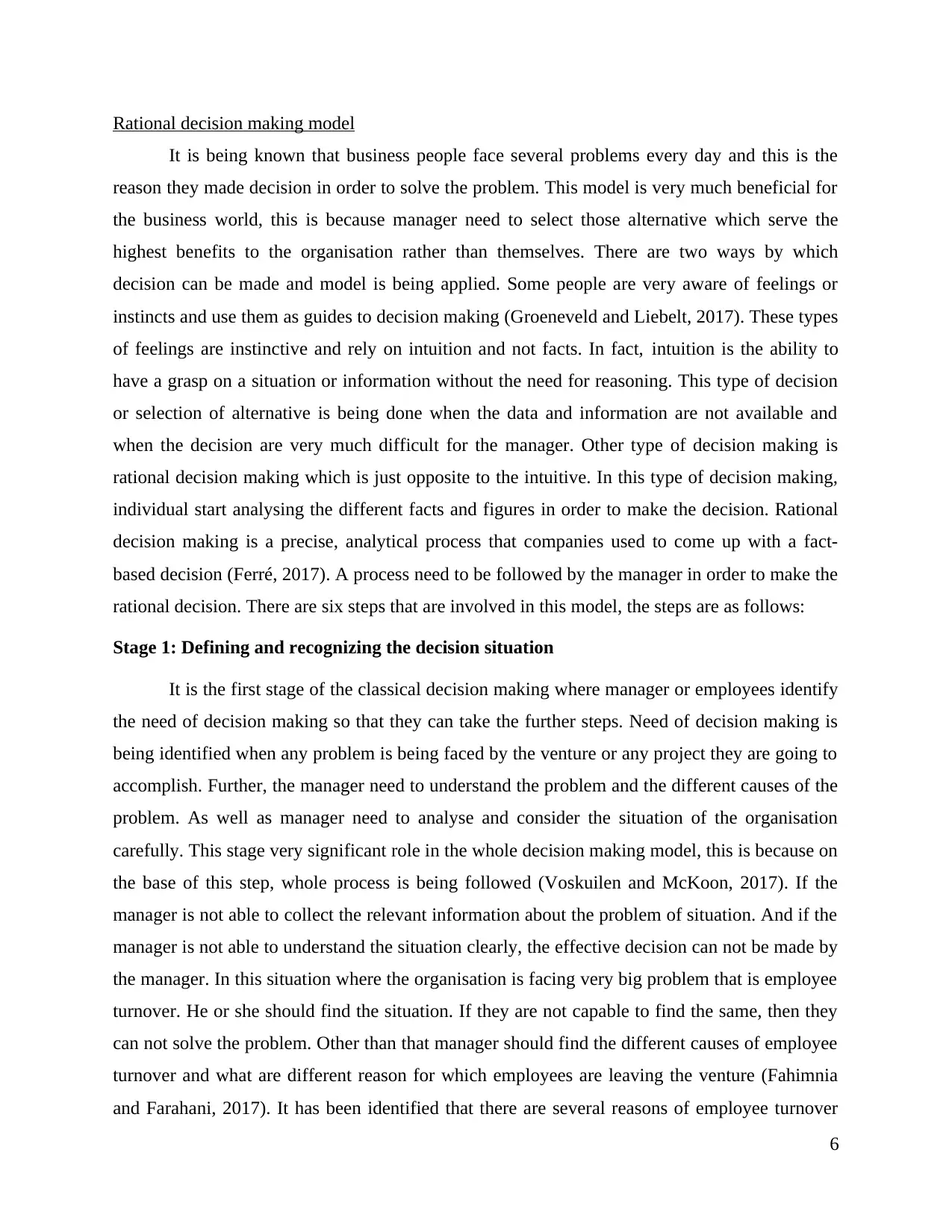
Rational decision making model
It is being known that business people face several problems every day and this is the
reason they made decision in order to solve the problem. This model is very much beneficial for
the business world, this is because manager need to select those alternative which serve the
highest benefits to the organisation rather than themselves. There are two ways by which
decision can be made and model is being applied. Some people are very aware of feelings or
instincts and use them as guides to decision making (Groeneveld and Liebelt, 2017). These types
of feelings are instinctive and rely on intuition and not facts. In fact, intuition is the ability to
have a grasp on a situation or information without the need for reasoning. This type of decision
or selection of alternative is being done when the data and information are not available and
when the decision are very much difficult for the manager. Other type of decision making is
rational decision making which is just opposite to the intuitive. In this type of decision making,
individual start analysing the different facts and figures in order to make the decision. Rational
decision making is a precise, analytical process that companies used to come up with a fact-
based decision (Ferré, 2017). A process need to be followed by the manager in order to make the
rational decision. There are six steps that are involved in this model, the steps are as follows:
Stage 1: Defining and recognizing the decision situation
It is the first stage of the classical decision making where manager or employees identify
the need of decision making so that they can take the further steps. Need of decision making is
being identified when any problem is being faced by the venture or any project they are going to
accomplish. Further, the manager need to understand the problem and the different causes of the
problem. As well as manager need to analyse and consider the situation of the organisation
carefully. This stage very significant role in the whole decision making model, this is because on
the base of this step, whole process is being followed (Voskuilen and McKoon, 2017). If the
manager is not able to collect the relevant information about the problem of situation. And if the
manager is not able to understand the situation clearly, the effective decision can not be made by
the manager. In this situation where the organisation is facing very big problem that is employee
turnover. He or she should find the situation. If they are not capable to find the same, then they
can not solve the problem. Other than that manager should find the different causes of employee
turnover and what are different reason for which employees are leaving the venture (Fahimnia
and Farahani, 2017). It has been identified that there are several reasons of employee turnover
6
It is being known that business people face several problems every day and this is the
reason they made decision in order to solve the problem. This model is very much beneficial for
the business world, this is because manager need to select those alternative which serve the
highest benefits to the organisation rather than themselves. There are two ways by which
decision can be made and model is being applied. Some people are very aware of feelings or
instincts and use them as guides to decision making (Groeneveld and Liebelt, 2017). These types
of feelings are instinctive and rely on intuition and not facts. In fact, intuition is the ability to
have a grasp on a situation or information without the need for reasoning. This type of decision
or selection of alternative is being done when the data and information are not available and
when the decision are very much difficult for the manager. Other type of decision making is
rational decision making which is just opposite to the intuitive. In this type of decision making,
individual start analysing the different facts and figures in order to make the decision. Rational
decision making is a precise, analytical process that companies used to come up with a fact-
based decision (Ferré, 2017). A process need to be followed by the manager in order to make the
rational decision. There are six steps that are involved in this model, the steps are as follows:
Stage 1: Defining and recognizing the decision situation
It is the first stage of the classical decision making where manager or employees identify
the need of decision making so that they can take the further steps. Need of decision making is
being identified when any problem is being faced by the venture or any project they are going to
accomplish. Further, the manager need to understand the problem and the different causes of the
problem. As well as manager need to analyse and consider the situation of the organisation
carefully. This stage very significant role in the whole decision making model, this is because on
the base of this step, whole process is being followed (Voskuilen and McKoon, 2017). If the
manager is not able to collect the relevant information about the problem of situation. And if the
manager is not able to understand the situation clearly, the effective decision can not be made by
the manager. In this situation where the organisation is facing very big problem that is employee
turnover. He or she should find the situation. If they are not capable to find the same, then they
can not solve the problem. Other than that manager should find the different causes of employee
turnover and what are different reason for which employees are leaving the venture (Fahimnia
and Farahani, 2017). It has been identified that there are several reasons of employee turnover
6
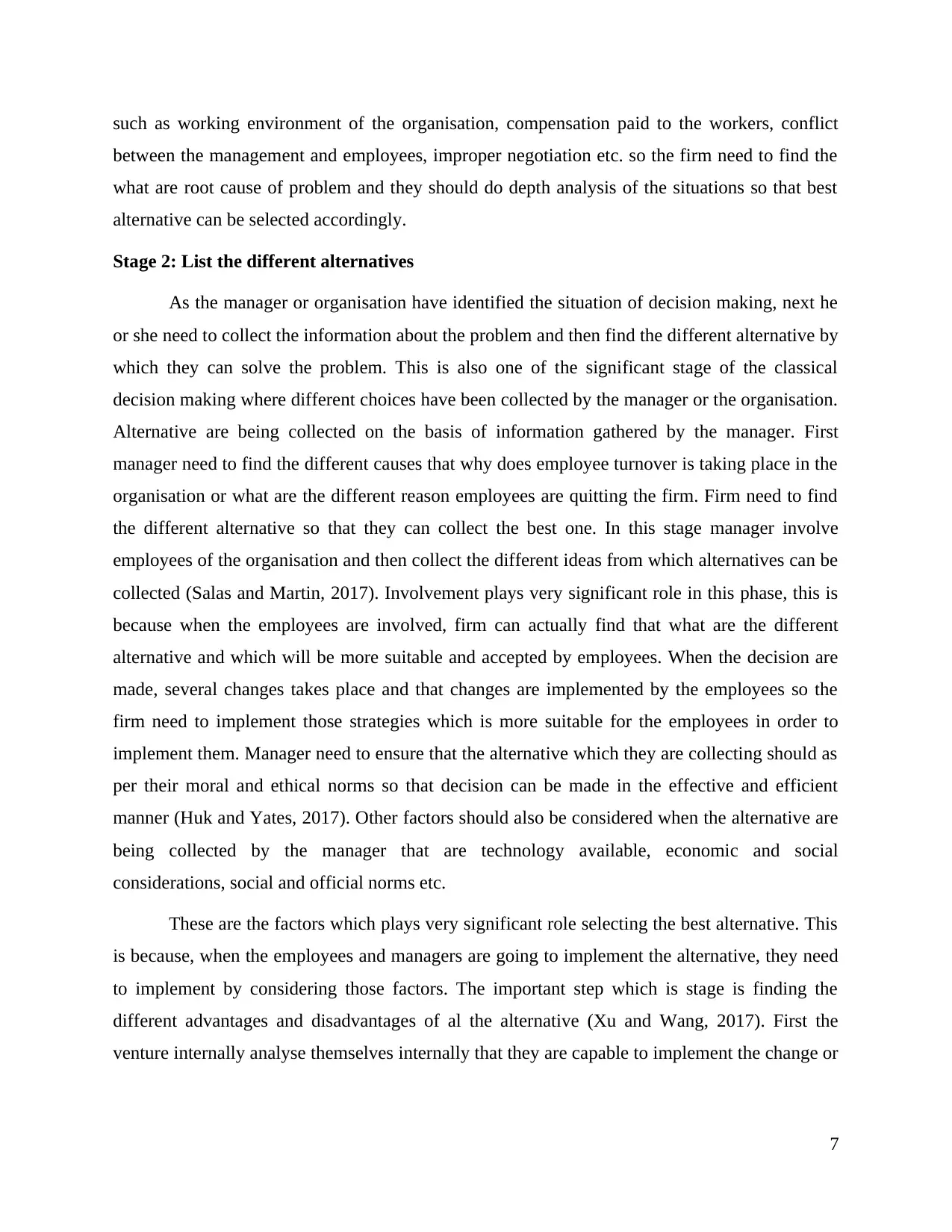
such as working environment of the organisation, compensation paid to the workers, conflict
between the management and employees, improper negotiation etc. so the firm need to find the
what are root cause of problem and they should do depth analysis of the situations so that best
alternative can be selected accordingly.
Stage 2: List the different alternatives
As the manager or organisation have identified the situation of decision making, next he
or she need to collect the information about the problem and then find the different alternative by
which they can solve the problem. This is also one of the significant stage of the classical
decision making where different choices have been collected by the manager or the organisation.
Alternative are being collected on the basis of information gathered by the manager. First
manager need to find the different causes that why does employee turnover is taking place in the
organisation or what are the different reason employees are quitting the firm. Firm need to find
the different alternative so that they can collect the best one. In this stage manager involve
employees of the organisation and then collect the different ideas from which alternatives can be
collected (Salas and Martin, 2017). Involvement plays very significant role in this phase, this is
because when the employees are involved, firm can actually find that what are the different
alternative and which will be more suitable and accepted by employees. When the decision are
made, several changes takes place and that changes are implemented by the employees so the
firm need to implement those strategies which is more suitable for the employees in order to
implement them. Manager need to ensure that the alternative which they are collecting should as
per their moral and ethical norms so that decision can be made in the effective and efficient
manner (Huk and Yates, 2017). Other factors should also be considered when the alternative are
being collected by the manager that are technology available, economic and social
considerations, social and official norms etc.
These are the factors which plays very significant role selecting the best alternative. This
is because, when the employees and managers are going to implement the alternative, they need
to implement by considering those factors. The important step which is stage is finding the
different advantages and disadvantages of al the alternative (Xu and Wang, 2017). First the
venture internally analyse themselves internally that they are capable to implement the change or
7
between the management and employees, improper negotiation etc. so the firm need to find the
what are root cause of problem and they should do depth analysis of the situations so that best
alternative can be selected accordingly.
Stage 2: List the different alternatives
As the manager or organisation have identified the situation of decision making, next he
or she need to collect the information about the problem and then find the different alternative by
which they can solve the problem. This is also one of the significant stage of the classical
decision making where different choices have been collected by the manager or the organisation.
Alternative are being collected on the basis of information gathered by the manager. First
manager need to find the different causes that why does employee turnover is taking place in the
organisation or what are the different reason employees are quitting the firm. Firm need to find
the different alternative so that they can collect the best one. In this stage manager involve
employees of the organisation and then collect the different ideas from which alternatives can be
collected (Salas and Martin, 2017). Involvement plays very significant role in this phase, this is
because when the employees are involved, firm can actually find that what are the different
alternative and which will be more suitable and accepted by employees. When the decision are
made, several changes takes place and that changes are implemented by the employees so the
firm need to implement those strategies which is more suitable for the employees in order to
implement them. Manager need to ensure that the alternative which they are collecting should as
per their moral and ethical norms so that decision can be made in the effective and efficient
manner (Huk and Yates, 2017). Other factors should also be considered when the alternative are
being collected by the manager that are technology available, economic and social
considerations, social and official norms etc.
These are the factors which plays very significant role selecting the best alternative. This
is because, when the employees and managers are going to implement the alternative, they need
to implement by considering those factors. The important step which is stage is finding the
different advantages and disadvantages of al the alternative (Xu and Wang, 2017). First the
venture internally analyse themselves internally that they are capable to implement the change or
7
⊘ This is a preview!⊘
Do you want full access?
Subscribe today to unlock all pages.

Trusted by 1+ million students worldwide
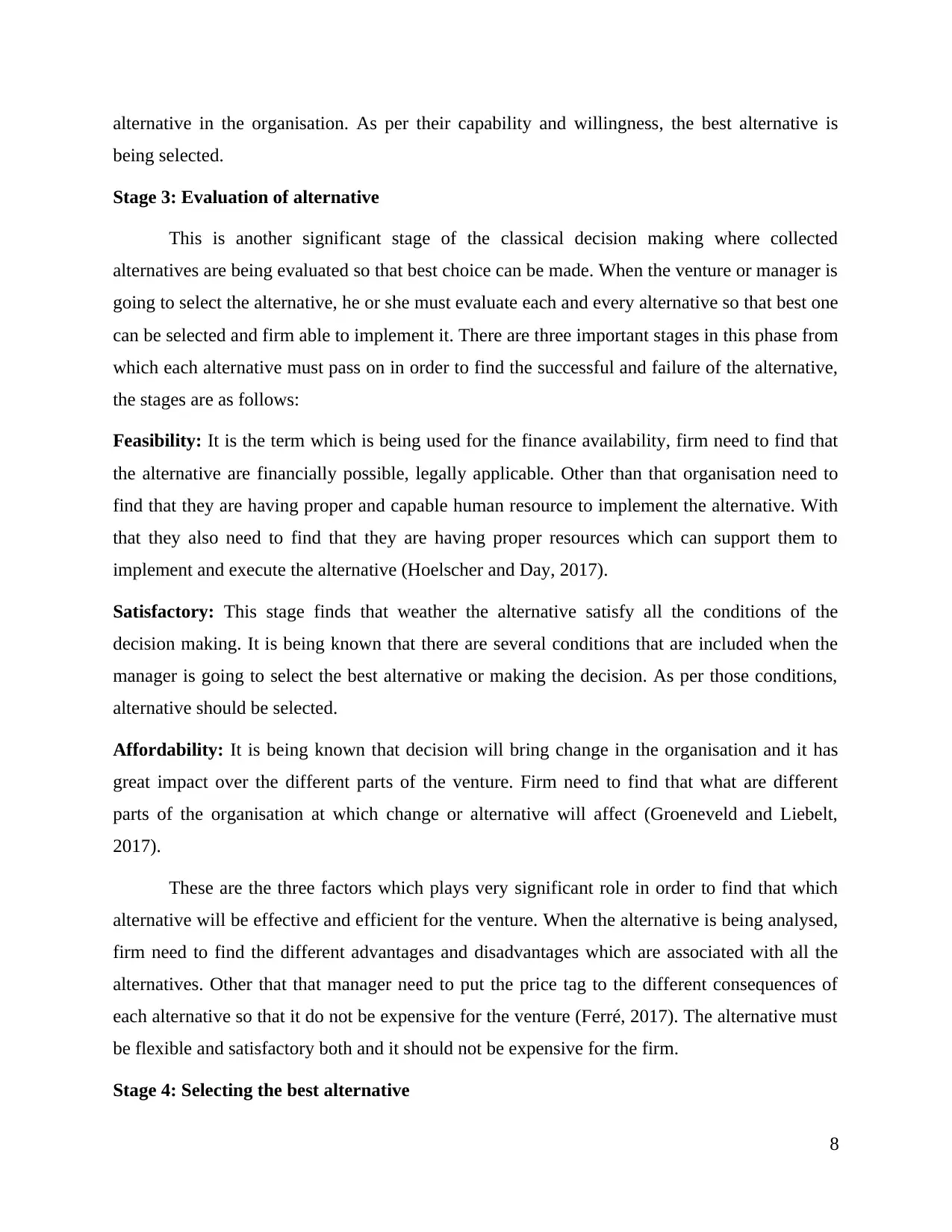
alternative in the organisation. As per their capability and willingness, the best alternative is
being selected.
Stage 3: Evaluation of alternative
This is another significant stage of the classical decision making where collected
alternatives are being evaluated so that best choice can be made. When the venture or manager is
going to select the alternative, he or she must evaluate each and every alternative so that best one
can be selected and firm able to implement it. There are three important stages in this phase from
which each alternative must pass on in order to find the successful and failure of the alternative,
the stages are as follows:
Feasibility: It is the term which is being used for the finance availability, firm need to find that
the alternative are financially possible, legally applicable. Other than that organisation need to
find that they are having proper and capable human resource to implement the alternative. With
that they also need to find that they are having proper resources which can support them to
implement and execute the alternative (Hoelscher and Day, 2017).
Satisfactory: This stage finds that weather the alternative satisfy all the conditions of the
decision making. It is being known that there are several conditions that are included when the
manager is going to select the best alternative or making the decision. As per those conditions,
alternative should be selected.
Affordability: It is being known that decision will bring change in the organisation and it has
great impact over the different parts of the venture. Firm need to find that what are different
parts of the organisation at which change or alternative will affect (Groeneveld and Liebelt,
2017).
These are the three factors which plays very significant role in order to find that which
alternative will be effective and efficient for the venture. When the alternative is being analysed,
firm need to find the different advantages and disadvantages which are associated with all the
alternatives. Other that that manager need to put the price tag to the different consequences of
each alternative so that it do not be expensive for the venture (Ferré, 2017). The alternative must
be flexible and satisfactory both and it should not be expensive for the firm.
Stage 4: Selecting the best alternative
8
being selected.
Stage 3: Evaluation of alternative
This is another significant stage of the classical decision making where collected
alternatives are being evaluated so that best choice can be made. When the venture or manager is
going to select the alternative, he or she must evaluate each and every alternative so that best one
can be selected and firm able to implement it. There are three important stages in this phase from
which each alternative must pass on in order to find the successful and failure of the alternative,
the stages are as follows:
Feasibility: It is the term which is being used for the finance availability, firm need to find that
the alternative are financially possible, legally applicable. Other than that organisation need to
find that they are having proper and capable human resource to implement the alternative. With
that they also need to find that they are having proper resources which can support them to
implement and execute the alternative (Hoelscher and Day, 2017).
Satisfactory: This stage finds that weather the alternative satisfy all the conditions of the
decision making. It is being known that there are several conditions that are included when the
manager is going to select the best alternative or making the decision. As per those conditions,
alternative should be selected.
Affordability: It is being known that decision will bring change in the organisation and it has
great impact over the different parts of the venture. Firm need to find that what are different
parts of the organisation at which change or alternative will affect (Groeneveld and Liebelt,
2017).
These are the three factors which plays very significant role in order to find that which
alternative will be effective and efficient for the venture. When the alternative is being analysed,
firm need to find the different advantages and disadvantages which are associated with all the
alternatives. Other that that manager need to put the price tag to the different consequences of
each alternative so that it do not be expensive for the venture (Ferré, 2017). The alternative must
be flexible and satisfactory both and it should not be expensive for the firm.
Stage 4: Selecting the best alternative
8
Paraphrase This Document
Need a fresh take? Get an instant paraphrase of this document with our AI Paraphraser
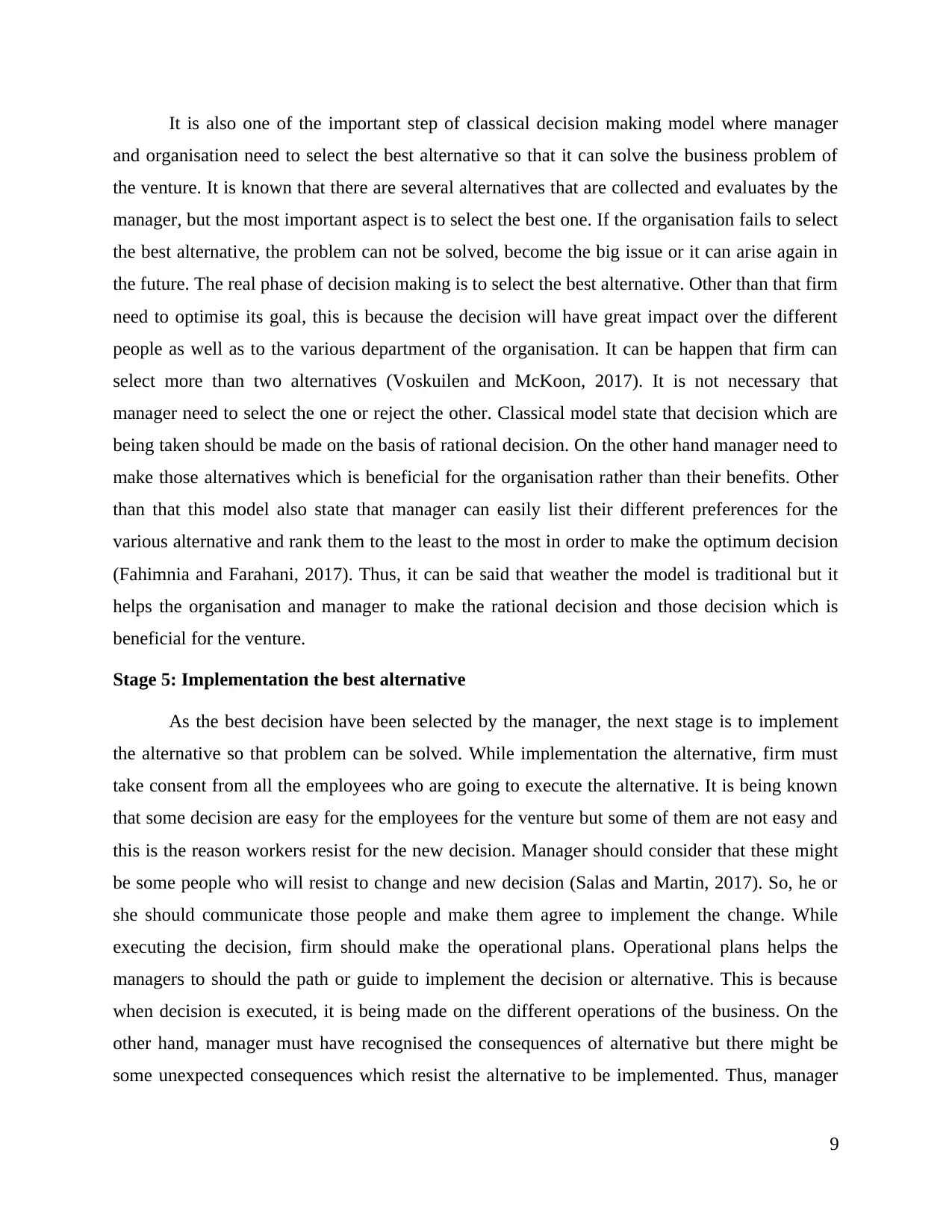
It is also one of the important step of classical decision making model where manager
and organisation need to select the best alternative so that it can solve the business problem of
the venture. It is known that there are several alternatives that are collected and evaluates by the
manager, but the most important aspect is to select the best one. If the organisation fails to select
the best alternative, the problem can not be solved, become the big issue or it can arise again in
the future. The real phase of decision making is to select the best alternative. Other than that firm
need to optimise its goal, this is because the decision will have great impact over the different
people as well as to the various department of the organisation. It can be happen that firm can
select more than two alternatives (Voskuilen and McKoon, 2017). It is not necessary that
manager need to select the one or reject the other. Classical model state that decision which are
being taken should be made on the basis of rational decision. On the other hand manager need to
make those alternatives which is beneficial for the organisation rather than their benefits. Other
than that this model also state that manager can easily list their different preferences for the
various alternative and rank them to the least to the most in order to make the optimum decision
(Fahimnia and Farahani, 2017). Thus, it can be said that weather the model is traditional but it
helps the organisation and manager to make the rational decision and those decision which is
beneficial for the venture.
Stage 5: Implementation the best alternative
As the best decision have been selected by the manager, the next stage is to implement
the alternative so that problem can be solved. While implementation the alternative, firm must
take consent from all the employees who are going to execute the alternative. It is being known
that some decision are easy for the employees for the venture but some of them are not easy and
this is the reason workers resist for the new decision. Manager should consider that these might
be some people who will resist to change and new decision (Salas and Martin, 2017). So, he or
she should communicate those people and make them agree to implement the change. While
executing the decision, firm should make the operational plans. Operational plans helps the
managers to should the path or guide to implement the decision or alternative. This is because
when decision is executed, it is being made on the different operations of the business. On the
other hand, manager must have recognised the consequences of alternative but there might be
some unexpected consequences which resist the alternative to be implemented. Thus, manager
9
and organisation need to select the best alternative so that it can solve the business problem of
the venture. It is known that there are several alternatives that are collected and evaluates by the
manager, but the most important aspect is to select the best one. If the organisation fails to select
the best alternative, the problem can not be solved, become the big issue or it can arise again in
the future. The real phase of decision making is to select the best alternative. Other than that firm
need to optimise its goal, this is because the decision will have great impact over the different
people as well as to the various department of the organisation. It can be happen that firm can
select more than two alternatives (Voskuilen and McKoon, 2017). It is not necessary that
manager need to select the one or reject the other. Classical model state that decision which are
being taken should be made on the basis of rational decision. On the other hand manager need to
make those alternatives which is beneficial for the organisation rather than their benefits. Other
than that this model also state that manager can easily list their different preferences for the
various alternative and rank them to the least to the most in order to make the optimum decision
(Fahimnia and Farahani, 2017). Thus, it can be said that weather the model is traditional but it
helps the organisation and manager to make the rational decision and those decision which is
beneficial for the venture.
Stage 5: Implementation the best alternative
As the best decision have been selected by the manager, the next stage is to implement
the alternative so that problem can be solved. While implementation the alternative, firm must
take consent from all the employees who are going to execute the alternative. It is being known
that some decision are easy for the employees for the venture but some of them are not easy and
this is the reason workers resist for the new decision. Manager should consider that these might
be some people who will resist to change and new decision (Salas and Martin, 2017). So, he or
she should communicate those people and make them agree to implement the change. While
executing the decision, firm should make the operational plans. Operational plans helps the
managers to should the path or guide to implement the decision or alternative. This is because
when decision is executed, it is being made on the different operations of the business. On the
other hand, manager must have recognised the consequences of alternative but there might be
some unexpected consequences which resist the alternative to be implemented. Thus, manager
9
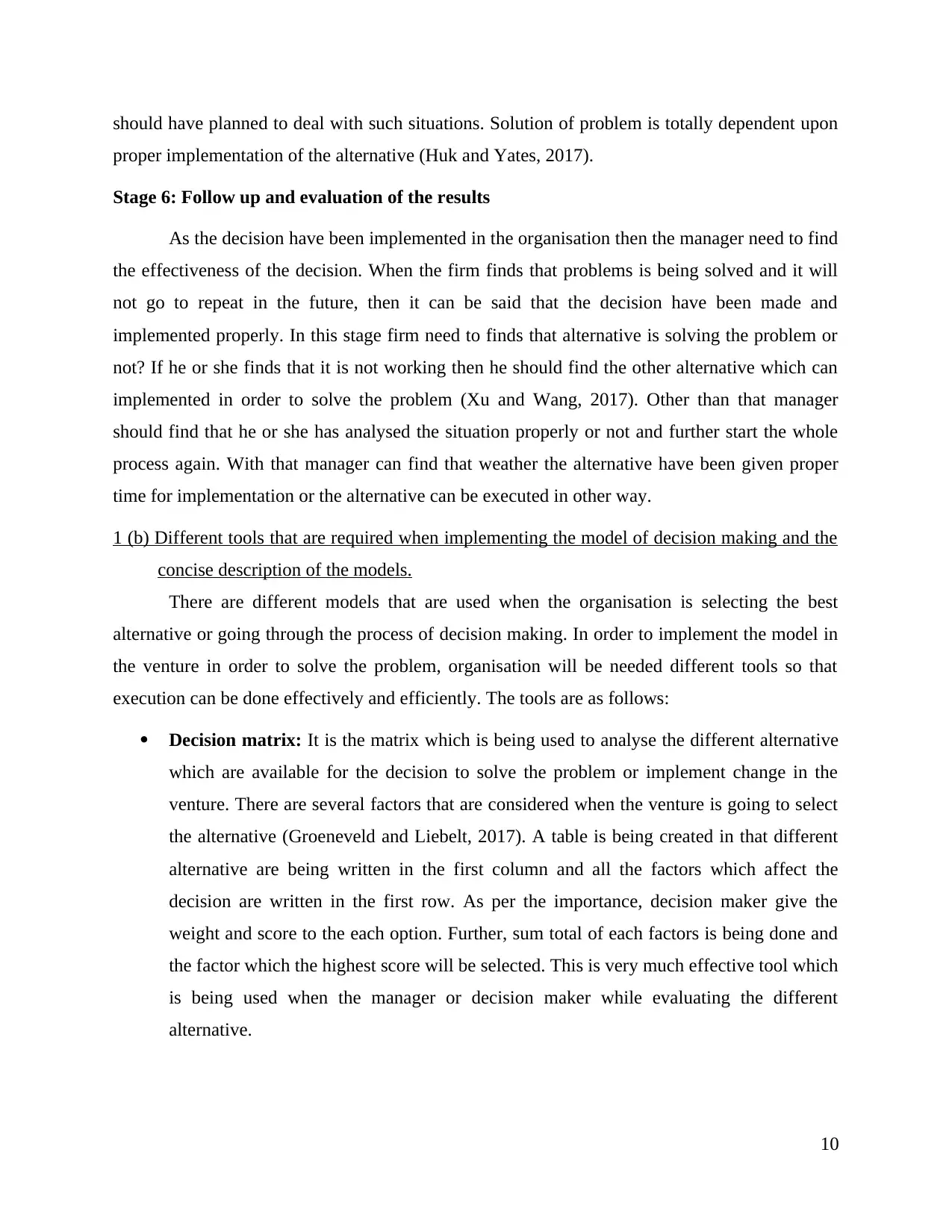
should have planned to deal with such situations. Solution of problem is totally dependent upon
proper implementation of the alternative (Huk and Yates, 2017).
Stage 6: Follow up and evaluation of the results
As the decision have been implemented in the organisation then the manager need to find
the effectiveness of the decision. When the firm finds that problems is being solved and it will
not go to repeat in the future, then it can be said that the decision have been made and
implemented properly. In this stage firm need to finds that alternative is solving the problem or
not? If he or she finds that it is not working then he should find the other alternative which can
implemented in order to solve the problem (Xu and Wang, 2017). Other than that manager
should find that he or she has analysed the situation properly or not and further start the whole
process again. With that manager can find that weather the alternative have been given proper
time for implementation or the alternative can be executed in other way.
1 (b) Different tools that are required when implementing the model of decision making and the
concise description of the models.
There are different models that are used when the organisation is selecting the best
alternative or going through the process of decision making. In order to implement the model in
the venture in order to solve the problem, organisation will be needed different tools so that
execution can be done effectively and efficiently. The tools are as follows:
Decision matrix: It is the matrix which is being used to analyse the different alternative
which are available for the decision to solve the problem or implement change in the
venture. There are several factors that are considered when the venture is going to select
the alternative (Groeneveld and Liebelt, 2017). A table is being created in that different
alternative are being written in the first column and all the factors which affect the
decision are written in the first row. As per the importance, decision maker give the
weight and score to the each option. Further, sum total of each factors is being done and
the factor which the highest score will be selected. This is very much effective tool which
is being used when the manager or decision maker while evaluating the different
alternative.
10
proper implementation of the alternative (Huk and Yates, 2017).
Stage 6: Follow up and evaluation of the results
As the decision have been implemented in the organisation then the manager need to find
the effectiveness of the decision. When the firm finds that problems is being solved and it will
not go to repeat in the future, then it can be said that the decision have been made and
implemented properly. In this stage firm need to finds that alternative is solving the problem or
not? If he or she finds that it is not working then he should find the other alternative which can
implemented in order to solve the problem (Xu and Wang, 2017). Other than that manager
should find that he or she has analysed the situation properly or not and further start the whole
process again. With that manager can find that weather the alternative have been given proper
time for implementation or the alternative can be executed in other way.
1 (b) Different tools that are required when implementing the model of decision making and the
concise description of the models.
There are different models that are used when the organisation is selecting the best
alternative or going through the process of decision making. In order to implement the model in
the venture in order to solve the problem, organisation will be needed different tools so that
execution can be done effectively and efficiently. The tools are as follows:
Decision matrix: It is the matrix which is being used to analyse the different alternative
which are available for the decision to solve the problem or implement change in the
venture. There are several factors that are considered when the venture is going to select
the alternative (Groeneveld and Liebelt, 2017). A table is being created in that different
alternative are being written in the first column and all the factors which affect the
decision are written in the first row. As per the importance, decision maker give the
weight and score to the each option. Further, sum total of each factors is being done and
the factor which the highest score will be selected. This is very much effective tool which
is being used when the manager or decision maker while evaluating the different
alternative.
10
⊘ This is a preview!⊘
Do you want full access?
Subscribe today to unlock all pages.

Trusted by 1+ million students worldwide
1 out of 26
Related Documents
Your All-in-One AI-Powered Toolkit for Academic Success.
+13062052269
info@desklib.com
Available 24*7 on WhatsApp / Email
![[object Object]](/_next/static/media/star-bottom.7253800d.svg)
Unlock your academic potential
Copyright © 2020–2025 A2Z Services. All Rights Reserved. Developed and managed by ZUCOL.





